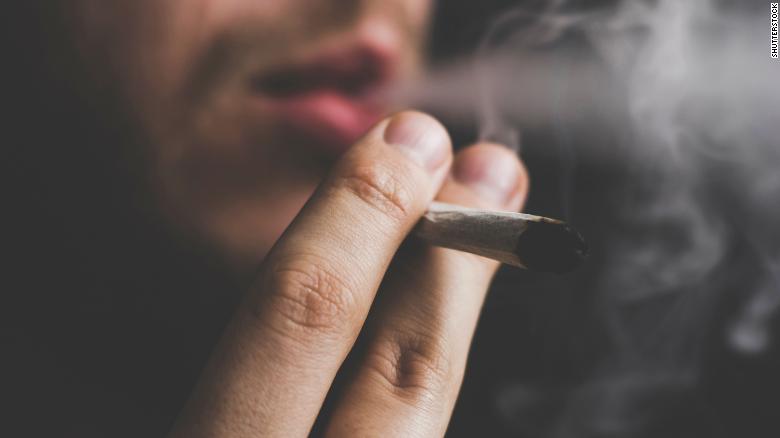Overuse of marijuana linked to schizophrenia 0:46
(CNN) -
An unusual disease is on the rise in the United States, especially in states that have legalized marijuana.
Regular cannabis users, including adolescents, report to emergency rooms complaining of severe intestinal discomfort.
"They squirm, clutch their stomach, complain of very bad abdominal pain and nausea," explains Dr. Sam Wang, a pediatric emergency medicine specialist and toxicologist at Children's Hospital Colorado, who treats teens with this condition.
"They vomit and then they keep throwing up what they have in their stomach, and it can last for hours," Wang said. "They often say they took a hot shower before coming to the ER, but it didn't help."
"That's when we know that we may have a case of cannabinoid hyperemesis syndrome, or SHC."
A strange condition
Cannabinoid hyperemesis syndrome burst onto the medical scene in 2004, when a group of Australian researchers wrote about 19 chronic marijuana users who had repeated episodes of abdominal pain and vomiting.
The researchers followed nine of the patients over time and found that the symptoms disappeared when they stopped using cannabis, but reappeared as soon as they resumed using cannabis.
Young adult cannabis users are nearly twice as likely to have a heart attack, research shows
Interestingly, more than half of the 19 patients reported using extremely hot baths or showers to alleviate symptoms.
As more and more cases of SHC began to appear, hot baths as a home treatment became a recurring theme.
"Patients often say, 'You know, it's always at night that I have this nausea, vomiting,'" Wang said. "So they tell me, 'I take a hot shower and it gets better, but then it happens again the next night.' ”.
advertising
"It's quite common for these patients to say that they need a very, very hot shower, or a very hot bath, to improve their symptoms," he said.
Why hot?
"That's not entirely clear," said Wang, who is also an associate professor of pediatrics at the Anschutz Medical Campus of the University of Colorado in Aurora, Colorado.
Tetrahydrocannabinol, or THC, the main psychoactive compound in marijuana, has access to the body's pain receptors, so one theory is that the distracting sensation of extreme heat interrupts the pain cycle, thereby relieving symptoms.
To compound the strangeness of the new disorder, THC and other cannabinoids from the marijuana plant have been used to relieve pain and, paradoxically, to relieve nausea and vomiting in cancer patients undergoing chemotherapy.
However, despite the popularity of marijuana as a pain reliever, the results of studies on its effectiveness have been inconclusive.
Legal marijuana: the countries in the Americas that have legalized the use of cannabis and those that have not
Still, why does the same compound soothe and also cause pain?
Among endless possibilities: dosage levels.
Wang points to the increasing potency of THC in current marijuana products.
"It is well documented that the amount of THC that now comes in cannabis is increasing substantially," Wang said. "In the 1990s the average was 4% or 5%. Now, in Colorado, it is between 15% and 20% ".
Another mystery: not all heavy marijuana users suffer from this syndrome.
"It's not entirely clear who is predisposed to it," Wang said. "Is it a certain frequency or duration of use? Is it a specific potency? Or is it a specific type of product? We don't have These data".
Research is not homogeneous
To fully understand, treat, and prevent this new disorder, researchers must document cases and compare symptoms.
But the SHC is so new that it does not have a medical diagnosis or insurance billing code, Wang said, making it "a moving target."
To investigate, scientists look at medical records for recorded cases of repetitive vomiting and compare them to marijuana use in one area.
Wang and his colleagues did just that in Colorado, where recreational marijuana was legalized in 2014. The use of medical marijuana has been legal since 2009.
Wang's analysis, published Friday in the JAMA Network Open magazine, found more than 800,000 reported cases of vomiting in Colorado between 2013 and 2018. That was an approximate 29% increase since marijuana was legalized in the state.
The rate was highest in counties that did not previously have marijuana dispensaries.
More than a third of the vomiting cases were in people 25 years of age or younger.
"This is not a rare problem," Wang said. "When a teenager comes in with cyclical abdominal pain and vomiting, my colleagues know that they should ask about cannabis use. It is quite common practice to see this and diagnose and treat it."
Immediate treatment consists of anti-nausea medications and intravenous fluids to combat dehydration from vomiting.
But patients also undergo a battery of tests to rule out other causes: blood and urine tests, expensive CT scans, nasty upper GI endoscopies, and gastric emptying tests, to name a few.
For some minors, these tests can be repeated over and over again.
"For some of the pediatric patients, this is their fifth emergency room visit in the past two months, with symptoms that they cannot control," Wang said.
And if they wait too long to show up, the SHC can put your life in danger.
"Regardless of whether it is cannabis hyperemesis syndrome or another virus that causes a lot of vomiting," Wang said, "if you let it go too long, you can have electrolyte disturbances, go into shock, and suffer organ failure. is different".
Concern for the future
The data shows that SHC is a national problem.
Between 2005 and 2014, when only medical marijuana was legal in most states, a 2020 study found that nearly one in five people hospitalized for cyclic vomiting in the United States reported concurrent cannabis use.
Get to know the cannabis garden outside the Mexican Congress that is open to the public
As of April, 17 states and the District of Columbia have legalized recreational marijuana for adults, while three dozen states and several territories have medical marijuana laws, according to the Pew Research Center.
A Pew Research Center survey revealed that the majority of American adults (60%) say that marijuana should be legal for medical and recreational use.
With such support, more states are likely to legalize marijuana in the coming years.
When this happens, Wang said he hopes people will also be aware of the potential dangers of cannabis, especially for young people.
"Adolescents and young adults are where there is growing concern about habitual use and its effect on physical and mental health," Wang said.
Marijuana vomiting









